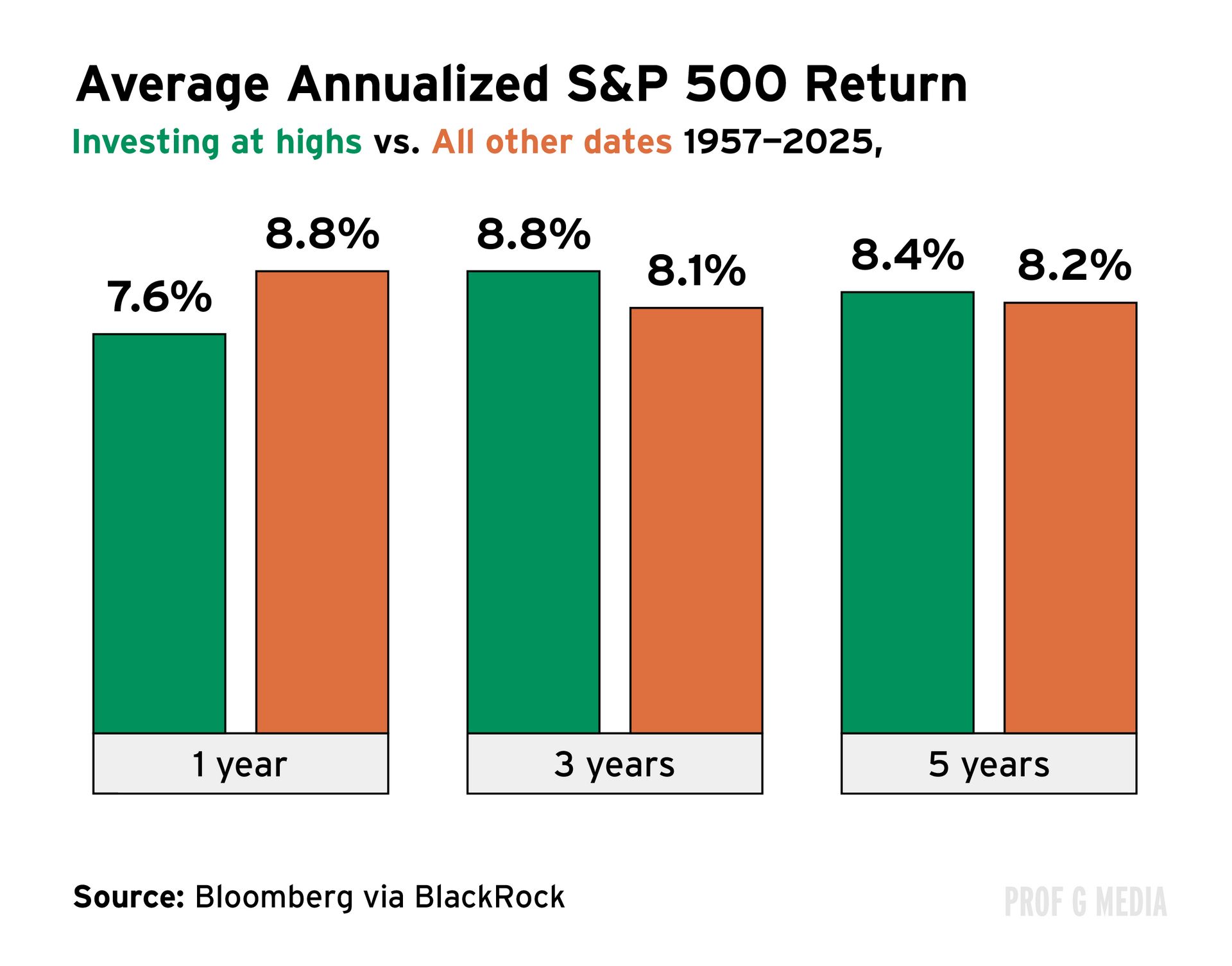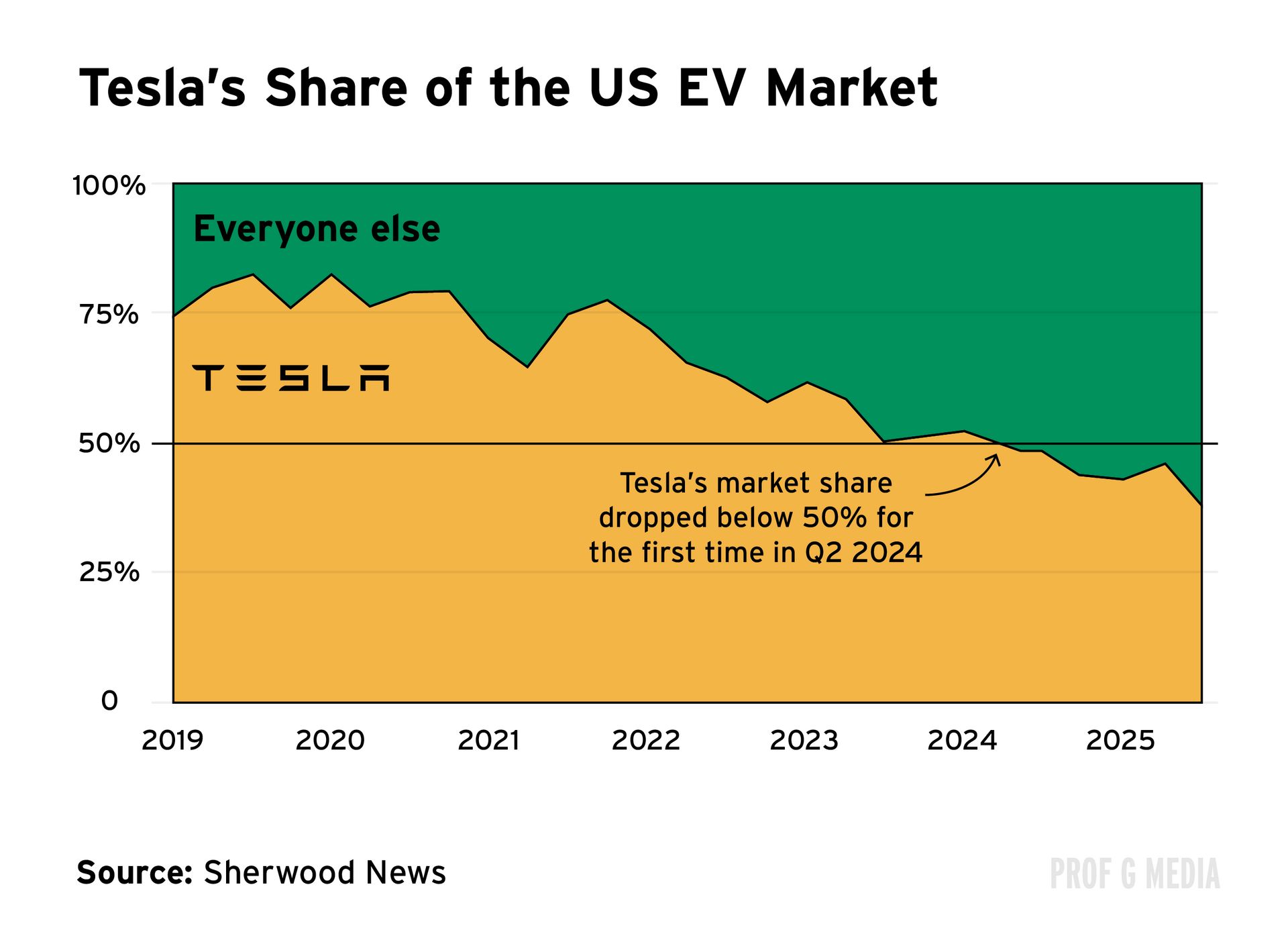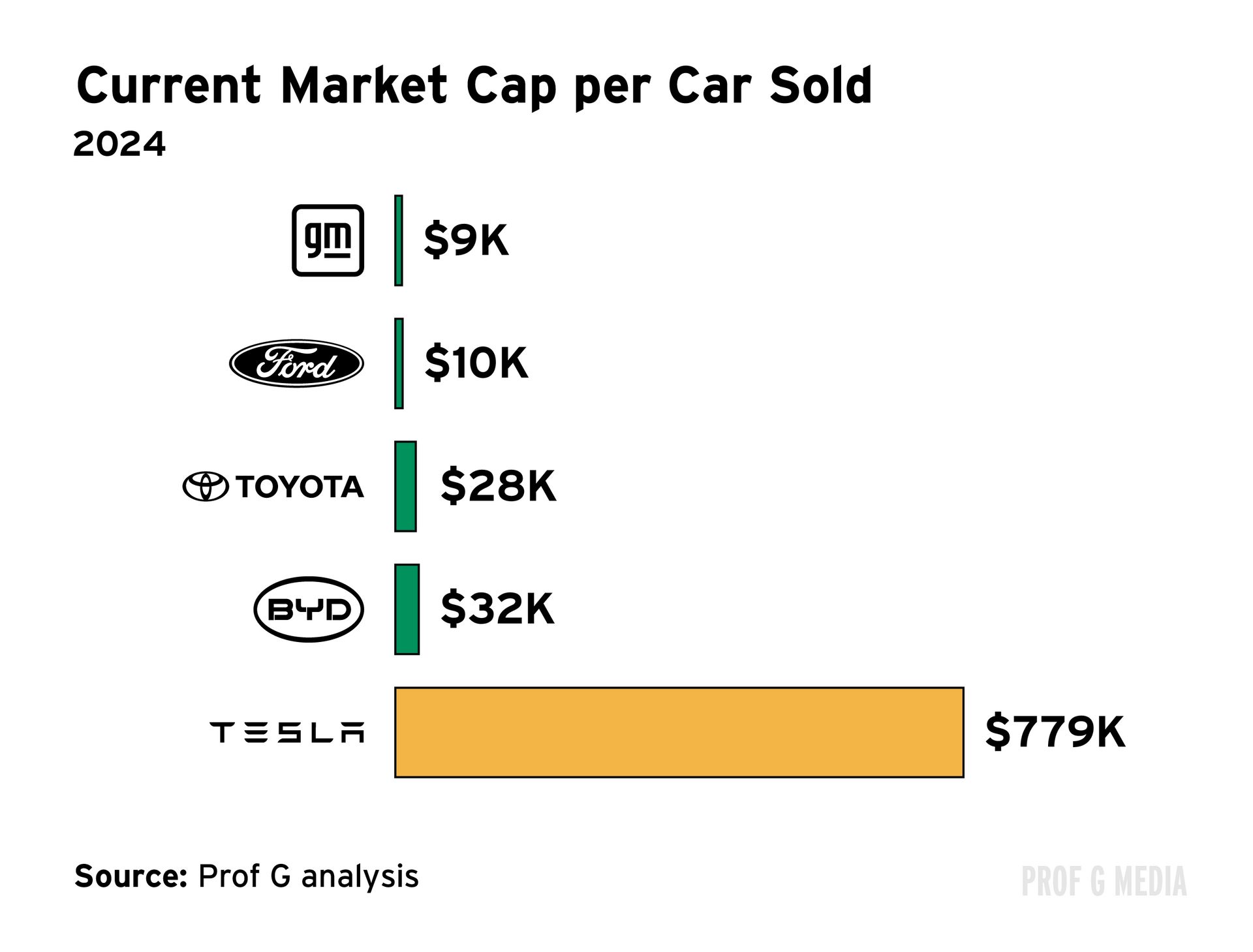In partnership with


$46,000
That’s how much Starbucks CEO Brian Niccol makes per hour (based on his 2024 pay). The median annual U.S. income is $45,000 - $1,000 less than Niccol makes in an hour.

How investors are responding to the (probable) AI bubble
Tesla’s robot revolution has been postponed
The uncomfortable truth behind America’s innovation edge over Europe
Newsletter exclusive: Why Anthropic’s new ad campaign is genius
The AI Bubble Is (Probably) Here. What Are Investors Doing About It?
A few weeks ago, we warned that the AI economy, propped up by a web of circular financing deals, might be headed for a collapse. Since then, the deals have continued. Last week, a new circular deal emerged between AMD and OpenAI worth tens of billions of dollars. Just a few days later, a $2 billion funding agreement was announced between Nvidia and xAI.
What used to be a hot take is now the consensus. Mainstream media and even AI founders are saying AI is a bubble:
Bret Taylor, OpenAI chair: “I think we’re also in a bubble.”
Ali Ghodsi, CEO of Databricks: “It’s peak AI bubble.”
What’s concerning is that much of the market’s strength — and the economy’s resilience — now seems to rely on that bubble.
AI companies have accounted for 80% of the gains in U.S. stocks year to date.
Technology and software investment (AI) was responsible for 92% of GDP growth in the first half of the year. Without it — GDP growth would have been flat.
This isn’t a controversial take anymore. So how are investors responding? One popular hedge this year has been gold.
Last week, gold hit $4,000 for the first time ever. The metal is up 121% since the end of 2022, its biggest rally since the 1970s.
Central banks are driving the demand for gold. Ninety-five percent of central banks plan to expand their gold reserves over the coming year.
This is part of the broader debasement trade — the idea that loose monetary policy (i.e., printing more and more money) will erode the value of fiat currencies. In this environment, investors seek hard assets like gold, which is scarce and has historically held its value better.
What started as institutional concern has now migrated to retail investors. Global gold ETFs hit $472 billion in assets under management (AUM), up 23% for the quarter to reach an all-time high. Gold has become a momentum trade.
Still, gold isn’t the only option. Historically, investing in the broader market at its peaks has had little impact on long-term returns.

The odds of a positive return if you invest in the S&P 500 and leave it for 10 years are ... 100%.
Trying to time the market or predict a bubble’s peak is nearly impossible, even for seasoned investors.
Consider this quote:
“By my count, we now have a stock bubble, a bond bubble, a gold bubble, a (new) housing bubble, a bitcoin bubble, a debt bubble, a profit bubble, a margin bubble, a Fed bubble, a dividend bubble, a social media bubble, a health care bubble, and an [insert thing you don’t like] bubble.”
Sounds like something from last week, right? It’s not.
That was Morgan Housel, now a partner at Collaborative Fund and New York Times bestselling author, in December 2013. His conclusion: No one has any idea what is going on.
He was right. Since then, the S&P 500 has climbed nearly 350%.

Ruchir Sharma, a journalist at the Financial Times, wrote an op-ed that America right now is just a giant bet on AI.
The cloud cover for Trump to do constitutionally and democratically damaging things is the fact that the S&P is up 12% this year. If the S&P were down 20%, I just don’t think there’d be troops going into Portland.
There’s a general indication that whatever the White House is doing is OK because the markets are up.
And the markets right now are being driven by 10 AI companies. So basically, AI is enabling the president.
Additionally, the top 10% of Americans own 90% of the stock market and make up half of all consumer activity. If the market does go down, say 15%, and the wealthy suddenly feel less wealthy and stop spending, they could trigger a downward economic spiral.
So America isn’t just a bet on AI, it’s a bet that rich people will continue to spend.

To address this question of when does the bubble pop, I would point out that valuations among big tech AI companies are high, but they’re not crazy high. The 24-month forward PE ratio of the Magnificent Seven is 27x. In the year 2000, at the height of the tech bubble, the top 10 stocks traded at 52x forward earnings. So I would say, yes, a bubble is forming, but I don’t think we’re at a point where we can say it’s about to pop.
That brings me to another point. There’s a general feeling that we should try to predict when recessions will hit. First, that’s impossible. Second, even if you get it right, the impact on your portfolio is actually not as meaningful as you might think. If you’re investing over five years, 10 years, 15 years, investing at the highs is almost no different.
The other thing to remember here is that you actually have a lot more time than you think. In recessions, historically, the average amount of time between the point at which the stock market peaks and the point at which the recession is officially called is nine months. You don’t need to call the recession before everyone else does. You might want to because you’ll feel smart, but the reality is there actually isn’t that much alpha in doing that. If you really wanna make money, keep on investing over the long term.
Tesla’s Robot Era Is Over
Tesla just quietly scrapped its plan to build 10,000 Optimus robots. According to The Information, the head of the Optimus project has left Tesla for Meta — even taking a pay cut to do so. This is another blow in what’s shaping up to be Tesla’s most fragile year in recent memory.
In September, Elon Musk said that Optimus robots could eventually make up 80% of Tesla’s enterprise value.
To put Tesla’s valuation in perspective: If it were to lose 80% of its current enterprise value, it would STILL be worth over $100 billion more than Ford and GM.
In August, Tesla’s U.S. market share hit a seven-year low, while European sales fell 43% year over year through August. And last week, the launch of cheaper Model Y and Model 3 Teslas left investors disappointed, dragging the stock down 4%.

Meanwhile, Tesla’s competition continues to heat up. GM, Nissan, and Hyundai all offer EV models that are cheaper than Tesla’s most inexpensive vehicle. In China, BYD’s Seagull costs less than $8,000 — well below Tesla’s cheapest model.
Musk once pitched Tesla as “more than a car company.” It might be time to refocus on the “car” part.


Every time the data comes out, I just cannot understand how you justify this valuation.
Everyone cheered Tesla’s September sales (up 7%), but those were a result of pull-forward demand from the EV tax credit expiring. Competitors did much better: Ford’s September sales were up 20%, and GM’s were up 107%.
These so-called cheap models they just unveiled? They’re actually more expensive than what a premium Tesla cost before the EV tax credit expired. Meanwhile in China, BYD’s Seagull costs $8,000. So you’ve got Tesla’s “cheap” car at $40,000 versus BYD’s at $8,000.
Yet the company trades at more than 200x earnings, while GM trades at 5x. It is so nonsensical, it’s hard to wrap your head around.
____________sponsored content ____________
Last week I told you about Incogni, and now I want to explain exactly how it works.
When you sign up, you fill out a short questionnaire with your personal information — name, date of birth, emails, phone numbers, and addresses. This allows their system to search the web for pages that contain your details.
Right away, Incogni starts sending takedown requests on your behalf. You’ll begin receiving email confirmations almost instantly. Like I’ve said before, it’s like a game of whack-a-mole — some listings are removed quickly, while others linger, and new ones keep popping up.
The good news is that Incogni keeps pushing to remove them all. When you log in, you’ll see a dashboard showing their progress. Right now, I’m at 302 requests sent, with 261 completed and 41 still in progress.
As you might expect, data brokers make a lot of money off your information, so some are in no rush to take it down. But so far, I’ve been impressed with how much of my personal data has been scrubbed from the web — which means fewer opportunities for scammers and identity thieves.
Before you slam your phone down in frustration over another potential scam call, give Incogni a try. It removes your sensitive information from people search sites and thousands of other databases that expose your private details. It’s an easy, one-stop solution for protecting your personal data.
Sign up at Incogni. Use my coupon code PROFG at checkout to save.
____________sponsored content ____________
The Freedom to Fail: America’s Edge Over Europe
Over the past two decades, the productivity of U.S. listed tech firms has increased by around 40%, while that of European tech firms has remained stagnant. Today, not a single European company ranks among the global top 25. The U.S. accounts for 20.
A recent article in The Economist attempts to explain why Europe has fallen so far behind, and it has to do with firing people.
The diagnosis: In many European countries, it’s too expensive to let employees go. The cost of firing in America is roughly seven months of that employee’s wages. In Germany and France, the cost is 31 and 38 months of wages, respectively. (That’s over two and a half years.)
This creates a risk-averse culture where companies avoid growth opportunities because they’re hesitant to hire. This makes Europe a particularly difficult place for startups. Nearly a third of European “unicorns” founded between 2008 and 2021 relocated elsewhere — usually to the U.S.

These challenges are holding Europe back in the AI race. Between 2019 and 2024, AI venture capital investment in the EU was just a tenth of that in the U.S.
There's more venture capital in Denver than in Paris, and more in New York than in the top two European cities (London and Paris) combined.
By contrast, America’s ability to hire (and fire) more freely may be one of the underappreciated engines of its dynamism. The freedom to fail, reset, and try again plays an important role in keeping the U.S. at the frontier of global innovation.
Research strengthens this thesis: One study of U.S. states showed that venture capital investment declines after the adoption of the strongest form of wrongful discharge laws (which provide limits to at-will employment).

I’ve probably hired 1,200 to 1,500 people in my career and fired 300 to 400. My mantra is hire slow, fire fast. Because when someone’s clearly not pulling their weight, keeping them around drags the whole team down. The best thing you can do for morale sometimes is a strategic firing. It tells the people who are working harder and better that you see them, you value them, and nobody gets to coast.
However, the broader point is that the ability to fire is what makes American companies so flexible and innovative. In the U.S. we err on the side of underregulation; however, I don’t think we should just let companies run wild. The best balance is less regulation, more room to innovate, and then higher taxes on those winners so we can fund child care, retraining, and unemployment.

We had economist Kathryn Anne Edwards on the show, and she added an important counterpoint to The Economist’s thesis. She argued that America doesn’t need European-style severance laws, but it does need stronger protections in other areas.
Universal paid sick leave, universal parental leave, and affordable child care would make it easier for workers, especially women, to stay in the labor force.
Universal sick leave alone could raise annual earnings for women without college degrees by roughly $3,000. Without this protection, U.S. workers can be fired for calling in sick, and mothers of young children are hit hardest, since kids get sick often.
So while Europe may overprotect with severance, America underprotects when it comes to benefits that allow people to balance work and family. The result is that too many Americans, particularly women, are locked out of sustainable, long-term employment.
Newsletter Exclusive: The AI Branding Wars Have Begun
AI models are getting better — all of them. The gap between the top and 10th-best has been cut in half in a year, and the top two models are basically tied.
Large language models are increasingly, and similarly competent because they are trained on largely the same datasets — the Common Crawl, a massive archive of webpages, Project Gutenberg, a collection of book text, Wikipedia, etc. Additionally, open source releases and intense scrutiny of newly released models mean that when one group makes an advance, it is quickly adopted or copied by competitors.
As products converge in quality, brand becomes the main differentiator. That’s why J.M. Smucker’s peanut butter brands, Jif, Smuckers, and others, hold 46% of the market, even though they cost more than store brands, which make up just 18%.
In Mad Men, when Don Draper told Lucky Strike executives that cigarettes offered the greatest advertising opportunity since the invention of cereal, his reasoning was, “We have six identical companies making six identical products. We can say anything we want.”
All cigarettes cause cancer, but by highlighting that Lucky Strikes are “toasted,” Draper differentiated it from other cigarettes.
AI is headed the same way, and so far, Anthropic is leading the AI branding wars by applying one of Prof G’s core principles: laddering.

The first weekend of October, Anthropic took over Air Mail’s West Village newsstand. Visitors lingered over coffee, books, pens, and paper.
More than 5,000 people stopped by, and posts about the event generated 10 million impressions, according to Anthropic.
It was a smart play to attract young users: More than half of those under 35 have attended in-person brand events.
For a company building such a futuristic tool, the branding felt surprisingly nostalgic … almost old money.


The installation was part of Anthropic’s “Keep thinking” campaign, which positions the company as a foil to the wave of AI-generated slop on the internet. The company’s ads feature people using Claude to think through tough problems.

This was classic “laddering,” a concept Scott coined. He explained it in an early No Mercy / No Malice post:
Laddering is an attempt to de-position a competitor by highlighting one of your strengths, which just happens to be your competitor’s weakness.
You cast yourself in a positive light, while at the same time casting a negative light on them. Remember when, in the wake of Cambridge Analytica, Tim Cook announced that “Privacy is a human right“? It’s the same as if Kara Swisher, my Pivot cohost, were to say, “I’m the host with good hair.” (Lethal.)
Laddering is effective, as it’s a twofer — people are organically reminded how much your adversary sucks, and by contrast how wonderful you are. We have an easier time believing people are bad vs. good — a survival mechanism.
This is exactly what Anthropic did. Just before OpenAI and Meta rolled out their slopification apps (which we covered last week), Anthropic launched its “Keep thinking” campaign and pop-up — positioning itself as the AI that wants humans to stay smart and connected.
It also mirrors Apple’s “Think different” ad. Apple framed itself as the tool for the “crazy ones” who think differently and change the world. Anthropic is making a similar play: Claude is the AI for people who still want to think for themselves.
Which brings us back to Don Draper. All advertising, he said, is based on happiness. And “Happiness is … freedom from fear. It’s a billboard on the side of the road that screams with reassurance that whatever you’re doing is OK.”
Anthropic’s campaign isn’t so much about thinking as it is about reassurance. Ironically, the “think with Anthropic” slogan attempts to release users from the anxiety, guilt, or fear of substituting AI for effort.

Either Palantir or Tesla will decline by 40% or more by the end of Q1 2026.

Scott and Ed sat down with economist Kathryn Anne Edwards to discuss how policy is failing the American workforce. They also dig into youth unemployment, the “tradwife” trend, and how ICE raids could reshape the labor force.

Ask what your gym can do for your country
20% of US kids aged 7 and younger have their own smartphone
Japan has a different kind of Halloween costume contest
